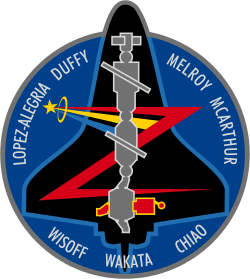Brian Duffy
| Brian Duffy | |
 | |
| NASA-Astronaut | |
|---|---|
| Född | 20 juni 1953 Boston |
| Tid i rymden | 40 dagar, 17 timmar, 37 minuter |
| Urvalsgrupp | Astronautgrupp 11 |
| Uppdrag | STS-45, STS-57, STS-72, STS-92 |
| Uppdragsemblem | |
Brian Duffy, född 20 juni 1953 i Boston, är en amerikansk astronaut uttagen i astronautgrupp 11 den 4 juni 1985.
Rymdfärder
Källor
”Biographical Data” (på engelska) (PDF). NASA. augusti 2002. https://www.nasa.gov/wp-content/uploads/2016/01/duffy_brian.pdf. Läst 5 maj 2024.
|
Media som används på denna webbplats
STS-57 Endeavour, Orbiter Vehicle (OV) 105, crew insignia (logo), the Official insignia of the NASA STS-57 mission, depicts the Space Shuttle Endeavour maneuvering to retrieve the European Retrievable Carrier (EURECA) microgravity experiment satellite. Spacehab -- the first commercial space laboratory -- is depicted in the cargo bay (payload bay (PLB)), and its characteristic shape is represented by the inner red border of the patch. The three gold plumes surrounded the five stars trailing EURECA are suggestive of the United States (U.S.) astronaut logo. The five gold stars together with the shape of the orbiter's mechanical arm form the mission's numerical designation. The six stars on the American flag represent the U.S. astronauts who comprise the crew. With detailed input from the crewmembers, the final artwork was accomplished by artist Tim Hall. The names of the STS-57 flight crewmembers are located along the border of the patch. They are Commander Ronald J. Grabe, Pilot Brian J.
STS-45 Mission Insignia
Designed by the crew members, the STS-92 patch symbolizes the second mission to carry U.S.-built elements to the International Space Station (ISS) for assembly. The black silhouette of the Space Shuttle Discovery stands out against the deep blue background of space in low Earth orbit. In the foreground in gray is a profile view of the ISS as it appears when the shuttle and crew arrive, with the station consisting of the Unity node, its two pressurized mating adapters (PMA), the Zarya functional cargo block, the Zvezda service module, and the Progress cargo vehicle.
Following the shuttle's rendezvous and docking, the ISS configuration will be augmented by the two elements delivered by Discovery–the Z1 truss and PMA-3. These two elements, depicted in red, will be installed using the shuttle's robot arm and be connected to ISS during four spacewalks. The multi-national nature of both the STS-92 crew and the ISS are reflected in the multi-colored Astronaut Office symbol.
STS-72 Mission Insignia
portrait astronaut Brian Duffy





